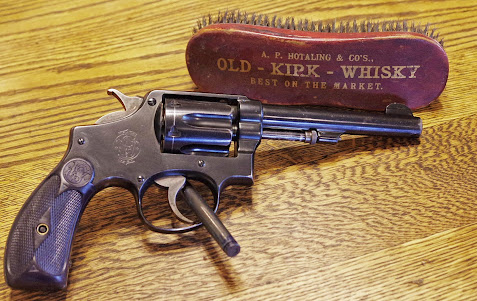What goes better with a turn of the century western whiskey than a pistol of the same period?
The tale of 33712
John C. Stewart was born in New Glasgow, Nova Scotia, on September 17, 1875. Like so many others seeking a better life in the land of milk and honey, he emigrated from his birthplace to the United States of America.
Dr. Darwin French led an expedition to an area in the SE desert of California in 1860 and discovered silver at Coso, nine miles from the future site of Darwin. Silver was discovered at Darwin proper in 1874, the same year that the boom to Panamint City occurred nearby in the Panamint range. Darwin quickly mushroomed and by 1876, boasted a thriving population of over 1000 souls. However, Darwin's time in the limelight was short lived as the deposits proved to be shallow, water was scarce, and ore values began to plummet starting in 1877. Despite its short lived window in the history of the Old West, Darwin proved to be one of the wickedest places on earth. Bodie paled by comparison when one compares the body count racked up during Darwin's short lived history, courtesy of both knife and gun. In its first three years of existence, between 1874 and 1877, there were said to be at least 80 murders, most of them unsolved.
Undaunted, John C. Stewart made his way west, determined to make his fortune as a miner. He arrived in Darwin, California in 1897, lured by the promise of finding a fortune in silver. John obviously lead at least a subsistence existence, but nothing newsworthy occurred. Based on facts and some sketchy evidence, we know that he purchased a Smith and Wesson model 1902 pistol, serial number 33712, at the Darwin General Store in early 1904. The gun had left the factory on Tuesday, December 1, 1903, shipped to a dealer in St. Louis. It was resold to the Darwin General Store and subsequently purchased by John. Chambered in "38 S&W Special / US Service Ctg's". It was a powerful and modern double action handgun that used the newly invented smokeless powder cartridge. It was good for keeping vermin, be they four or two legged, at bay.
Little is known about John's life, his successes and or failures, for the next couple of decades. However, he must have been able to eke out a living as a jackass prospector, ranging far and wide in the hills around Darwin and throughout the area bordered on the northeast by the then booming strikes at Goldfield and Tonopah.
That was, not until March of 1929. It was at that time that Smith and Wesson received 33712 back at the factory along with a note from John. He listed three requests; fix the loose barrel, refinish it, and install a set of pearl handle grips. John must have finally made a strike.
Johns requests were obliged, (for the most part) and the gun left their repair facility on May 1, 1929 with a "tightened barrel" and new finish. The tab; about $7~. Unfortunately, they were out of Pearl Handle grips, and the gun was returned with the desert worn originals. John, disappointed that he couldn't walk heeled down the street with gussied up grips, took matters into his own hands. He had a local make new wooden grips that served two purposes, they shifted his grip back so that the trigger guard would no longer slam into his middle finger when fired, and they looked "purdy".
John got careless one day, a year or two after he had the gun spruced up, and it ended up being lost by the side of a gravel road outside of Darwin. My ex-wife's grandfather, Herman, worked for the road department, and spotted the gun lying in the dirt while making his rounds. He asked around town, but no one had heard of a missing pistol, and John and his trusty burro must have been out looking for their next big strike.
The gun sat in the dresser drawer in Herman's bedroom, wrapped in an oiled rag until they departed Darwin in the early 30's. Herman had a son, Dick, and when Herman died, Dick inherited the gun. It sat in the same oiled rag that had been its home for another forty years, in Dick's bedroom dresser. Several years ago, Dick's health took a turn for the worse. With the writing on the wall, he gifted it to me. I was grateful.
I've always been a stickler for historical authenticity, and the "gussied up grips" bugged me. I made a concerted effort to locate a pair of period correct walnut or guttapercha grips for it. It took a while but I finally located a pair and replaced the grips, restoring 33712 to its original glory.
Being an historian, I was also curious about, what Paul Harvey used to call the "Rest of the Story". With the help of a new found, and extremely knowledgeable, acquaintance we were able to connect most of the dots. Many of which you've just read. We were also able to determine that this is a model 1902 (pre first change) and that there were only approximately 13000 of this variant that left the factory. Markings on the guns grip frame document that it is original as when it left the factory, with the exception of the metal work, reseating of the barrel, and the replacement grips.
As for John C. Stewart; he died in Darwin on May 23, 1947 of "heart trouble". His occupation was still listed, simply, as "miner".
Many thanks John, and Herman, and Dick for allowing me to be the custodian of an incredible piece of the wild west.










